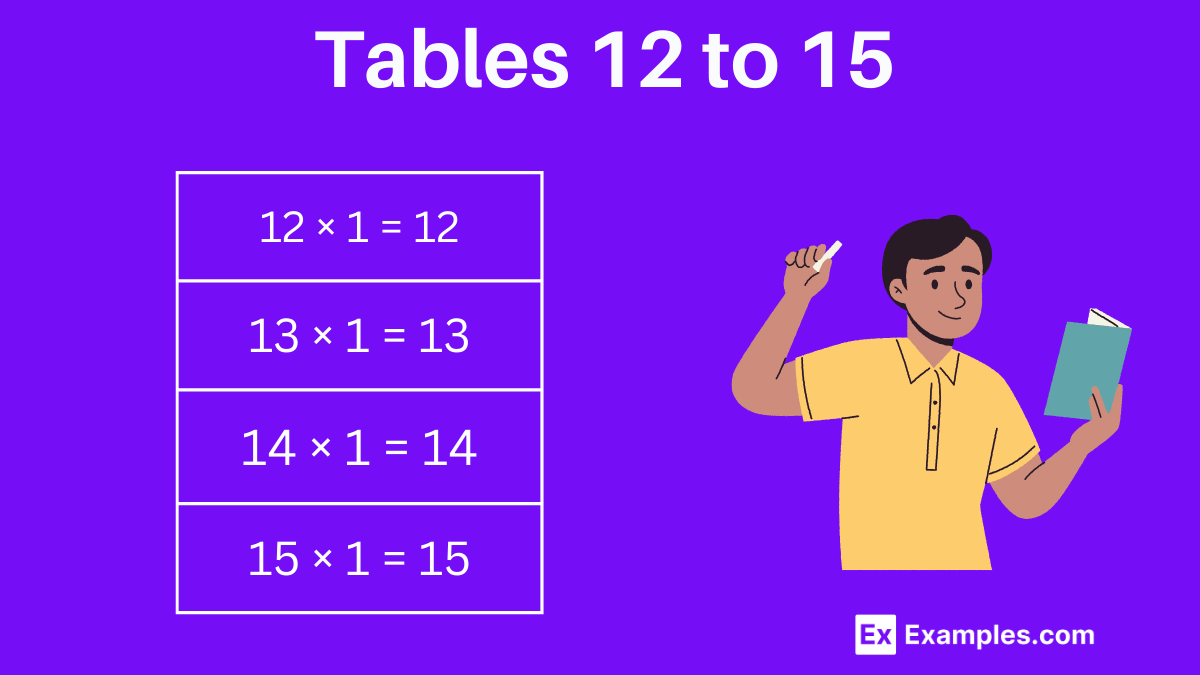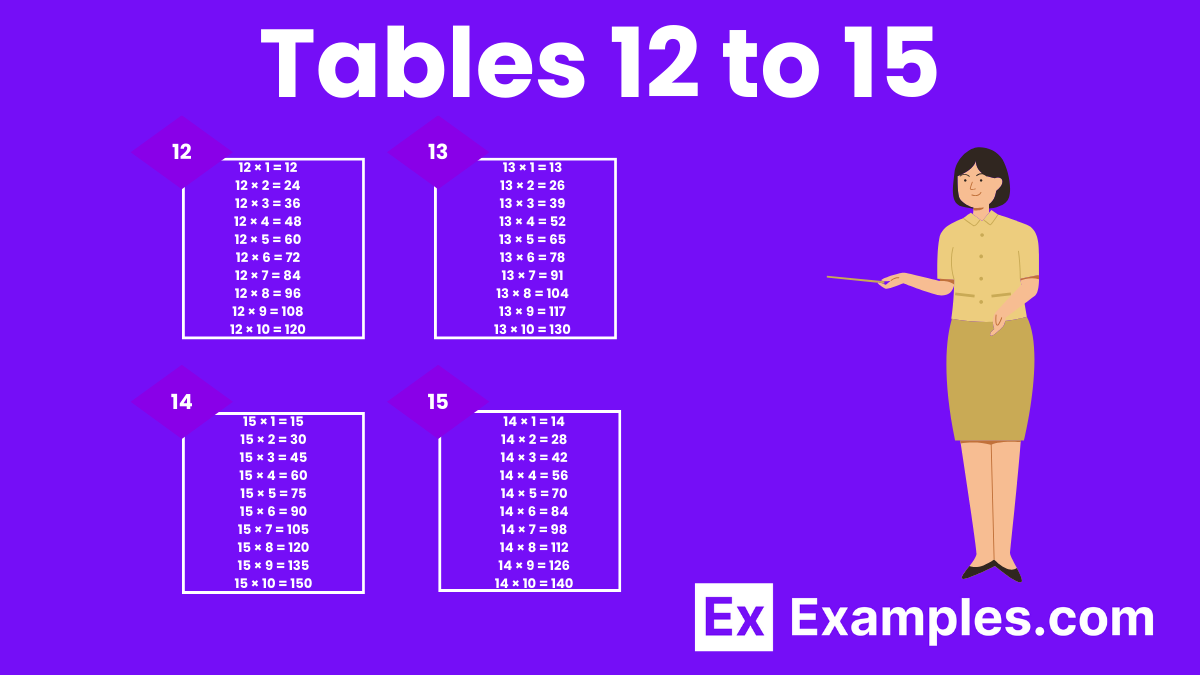What number should be multiplied with 12 to get 108?
7
8
9
10


The multiplication chart for tables 12 to 15 offers a focused resource for mastering higher multiplication facts. It is designed for deep understanding and quick recall, enhancing students’ arithmetic skills and confidence in handling more complex mathematical operations.

Download Tables From 12 to 15 Chart Pdf
The multiplication chart covering tables 12 to 15 is a focused educational tool designed to assist students in mastering higher multiplication facts efficiently. This segment of multiplication tables often poses a challenge due to the larger numbers involved, making a dedicated chart for these tables particularly useful. It provides a clear, organized visual reference that helps students reinforce their learning and improve their quick calculation skills, essential for advanced mathematical tasks and everyday problem-solving. This chart is especially beneficial in classroom settings or for individual study, ensuring students can approach these higher tables with confidence.
Download Tables From 12 to 15 Chart Pdf
| 12 Table | 13 Table | 14 Table | 15 Table |
|---|---|---|---|
| 12 x 1 = 12 | 13 x 1 = 13 | 14 x 1 = 14 | 15 x 1 = 15 |
| 12 x 2 = 24 | 13 x 2 = 26 | 14 x 2 = 28 | 15 x 2 = 30 |
| 12 x 3 = 36 | 13 x 3 = 39 | 14 x 3 = 42 | 15 x 3 = 45 |
| 12 x 4 = 48 | 13 x 4 = 52 | 14 x 4 = 56 | 15 x 4 = 60 |
| 12 x 5 = 60 | 13 x 5 = 65 | 14 x 5 = 70 | 15 x 5 = 75 |
| 12 x 6 = 72 | 13 x 6 = 78 | 14 x 6 = 84 | 15 x 6 = 90 |
| 12 x 7 = 84 | 13 x 7 = 91 | 14 x 7 = 98 | 15 x 7 = 105 |
| 12 x 8 = 96 | 13 x 8 = 104 | 14 x 8 = 112 | 15 x 8 = 120 |
| 12 x 9 = 108 | 13 x 9 = 117 | 14 x 9 = 126 | 15 x 9 = 135 |
| 12 x 10 = 120 | 13 x 10 = 130 | 14 x 10 = 140 | 15 x 10 = 150 |
Problem: 12 x 3 = ?
Solution: 12 x 3 = 36 (Multiplying 12 by 3 yields 36.)
Problem: 13 x 4 = ?
Solution: 13 x 4 = 52 (Thirteen times four equals fifty-two.)
Problem: 14 x 5 = ?
Solution: 14 x 5 = 70 (Fourteen multiplied by five results in seventy.)
Problem: 15 x 6 = ?
Solution: 15 x 6 = 90 (Fifteen times six equals ninety.)
Problem: 12 x 7 = ?
Solution: 12 x 7 = 84 (Twelve times seven equals eighty-four.)
Problem: 13 x 8 = ?
Solution: 13 x 8 = 104 (Thirteen multiplied by eight results in one hundred four.)
Problem: 14 x 9 = ?
Solution: 14 x 9 = 126 (Fourteen times nine yields one hundred twenty-six.)
Problem: 15 x 10 = ?
Solution: 15 x 10 = 150 (Fifteen times ten equals one hundred fifty.)
Problem: 12 x 11 = ?
Solution: 12 x 11 = 132 (Twelve times eleven equals one hundred thirty-two.)
Learning multiplication tables from 12 to 15 helps students perform quicker calculations and facilitates a smoother transition into higher mathematics, such as algebra and geometry. These tables are particularly useful in real-world applications like financial calculations and measurements.
For best results, daily practice is recommended initially until students feel comfortable with the tables. After that, regular review sessions a few times a week can help maintain their proficiency.
Yes, a strong grasp of multiplication aids in subjects like physics, chemistry, economics, and computer science, where mathematical calculations are frequently used to solve problems and analyze data.
Text prompt
Add Tone
10 Examples of Public speaking
20 Examples of Gas lighting
What number should be multiplied with 12 to get 108?
7
8
9
10
If 13 is multiplied by which number, the result is 91?
6
7
8
9
Which of the following is not a multiple of 14?
56
70
84
90
What is the missing number: 15 × _ = 180?
10
11
12
13
If 14 times a number equals 154, what is the number?
9
10
11
12
What is the product of 12 and the sum of 6 and 5?
121
132
144
156
How many times does 15 fit into 195?
11
12
13
14
Which of the following numbers is a multiple of 13?
95
104
115
126
If 12 times a number equals 144, what is the number?
10
11
12
13
What is the missing number: 14 × _ = 196?
13
14
15
16
Before you leave, take our quick quiz to enhance your learning!

